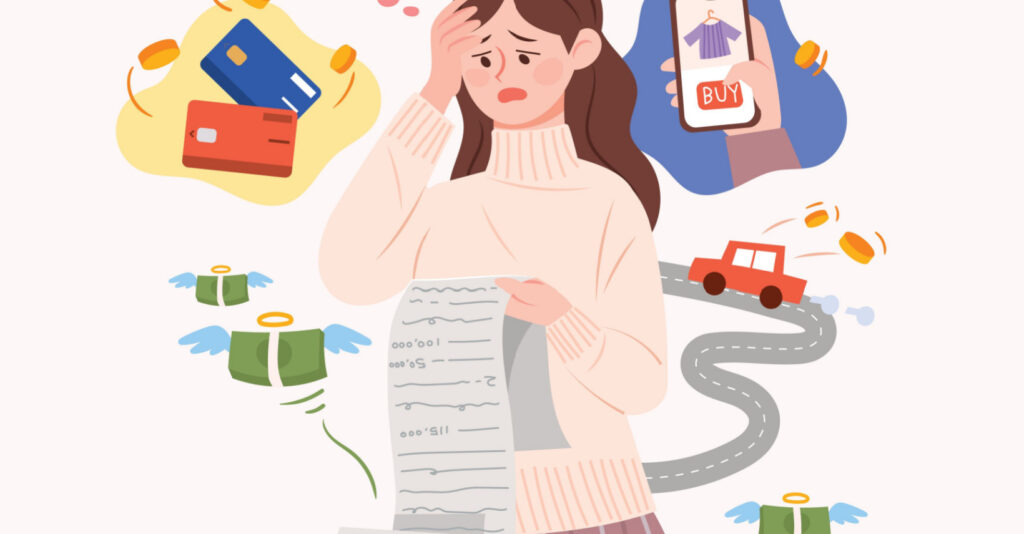The COVID-19 epidemic closed down most of the country, forcing many people to lose their jobs and money. When everything reopened, inflation took hold. In 2022, the United States and much of the rest of the globe faced crippling inflation. Grocery costs skyrocketed, as did fuel prices and loan interests. Everything is pricey. The national annual inflation rate reached a 40-year high in June of 2022, which means your money isn’t purchasing what it used to. Most Americans are feeling the effects of inflation, so if things feel tighter than usual, you are not alone!
Overspending is frequently the outcome of a succession of minor purchases rather than a single large purchase. As nondiscretionary commodities such as food, housing, and energy prices rise, families may need to cut back on spending to make ends meet. Like us, you probably thought, “Really? Cut back on spending? I’ve cut back as much as possible! I don’t think there’s anything else I can do!”
And just like a 1960’s infomercial, we’re gonna say, “But wait, there’s more!”
When considering your monthly expenses, you probably think of the main ones: housing, food, utilities, and other necessities. But what about those recurrent monthly costs you’re not aware of? It’s highly possible you have some hidden costs in your budget that you are paying for without even realizing it.
If you’re looking for ways to save money, you might be amazed at how many useless goods are buried in your daily costs. From memberships you may have forgotten to cancel to seldomly used expensive services you can downgrade, here is a simple guide to uncovering hidden expenses that are hurting your budget.
Make a list
The most significant and first step in uncovering hidden expenses hurting your budget is to make a list of your spending. To do this:
- Look at your credit card statements and debit card transactions.
- Don’t forget any cash purchases or payments you made—even a soda at the gas station counts. You can make a spreadsheet or just use pen and paper.
- Try to go back for 30 days. After you’ve written everything out and have an accurate snapshot of your spending, it’s time to look at where you can cut back.
Lower Your Cell Phone Bill
Cell phone plan options are constantly changing. Examine the most recent alternatives and your current data use to determine whether you may benefit from a lesser data plan or a family saving plan. If you’ve been a long-term client or are considering moving carriers, you may be able to reduce the cost of your plan with only a simple conversation. For example, many times, calling the carrier and negotiating can lower your bill. They want to keep your business. Remember to be courteous, as kindness can go a long way.
You can also lower your cell phone bill by looking at the charges. Often, carriers charge you for things you aren’t using, such as location services or hotspot wifi. In addition, if you don’t use much data, you may be able to cut your bill by dropping from an unlimited plan to a data-limited one.
Cutting Streaming Services
Almost all of us have this one in common. After all, binge-watching became one of the only forms of entertainment during lockdown. However, one of the biggest problems with streaming is that you can easily lose track of all your subscriptions and rack up a hefty monthly bill. In addition, with so many streaming options available now, it can be hard to limit yourself to just one or two. While the cost is usually much lower than a satellite or cable package, paying for multiple streaming services can quickly end up costing the same, if not more.
To cut expenses, you can do a “subscription cleansing .”Cancel all your regular subscriptions and only reactivate those you truly miss after a few weeks. Another way to cut streaming costs is to simply limit yourself to one or two services at a time. Then, it will be easy to see which ones you have on the list of expenses you created.
Credit card Interest Payments/Debt
When credit cards are involved, overspending tends to spiral. With interest rates above 20%, credit card debt eats up any wiggle room in your budget. Many experts recommend managing credit card debt first, followed by less expensive debt.
To avoid paying solely interest, make your minimum payments and extra if possible. You should also think about how you may reduce your credit card interest. For example, if you have a significant amount of credit card debt with a high-interest rate, try transferring the balance to a credit card with a 0% initial annual percentage rate. Of course, this may only be possible if you have decent credit, but it’s still worth a try.
Eating Out
According to the Bureau of Labor Statistics, the average household spends $3,000 per year dining out. Takeout and restaurant meals quickly add up. When you have your meals delivered, eating out becomes even more expensive. Cooking at home is nearly always the less expensive alternative. Even if you aren’t a culinary genius, grocery shopping and eating at home can save you loads of money. And let’s face it, with so many free cooking videos available, you can easily learn how to make your favorite dishes at home. We’ve even got a lot of excellent cheap recipes right here in the Branded Daily Digest!
You can also cut your eating expenses by changing the way you shop for groceries. For example, you can avoid what is known as “impulse buying” by doing online orders for pick-up. By shopping from your computer, you tend only to buy the most necessary items. As a result, you won’t see something on the shelf you didn’t plan for and grab it out of impulse. Additionally, picking up your order at your local supermarket is convenient, saves time, and simplifies your life. That’s a win/win!
 Coffee and Gas Station Snacks
Coffee and Gas Station Snacks
Grabbing your morning coffee from the coffee shop hurts your pocketbook more than you think. With high-end coffee often exceeding $5 a cup, you can easily spend over $100 monthly on your favorite beverage. Instead, consider getting back to basics at home with a French press or a Mr. Coffee. You can add all the bells and whistles and still have a great cup of joe just the way you like it!
Gas stations bank on you running inside for a soda or candy bar. If you grab a cold drink every time you gas up or drive to work, you are spending a lot more money than you think. You can eliminate this expensive habit by purchasing a case of your favorite drink from the grocery store and simply bringing one with you when you leave the house. If it’s the colder months, you can even put them in the trunk of your car! (Although, don’t let them freeze. That’s a disaster.)
App Subscriptions
Here’s another hidden expense we’re all guilty of forgetting—app subscriptions. Apps for your phone or computer can easily be forgotten about, and they charge automatically. You can view your app subscriptions on your phone from Google Play or the iPhone App Store. Then, cancel the apps you don’t use or those you don’t need.
There are millions of apps out there and likely hundreds for the service you want. Most of them offer free trials. As long as you keep an eye on your trial end dates, you can live off free trials for a long time. Also, do you really need two music apps? Choose just one. The same goes for audiobooks and sleep, meditation, and weather apps.
Examine Your Bills Closely
Besides making a list of your expenses, the best thing you can do to cut costs is to examine your bills closely and learn how to budget correctly. What precisely do you pay for every month? Look into what you’re being charged for in the first place. A monthly fee for a service or function you seldom use may be small, but it may quickly pile up over a year. Examine the line items on your next bill for a service such as cable, internet, or even a gym membership to determine whether you’re paying for something you don’t need.
Uncovering hidden expenses can be an eye-opener. But the good news is a little investigation can put you in a better place financially. It only takes a small amount of effort, and you can easily stop throwing away precious dollars for things you don’t use or need.












